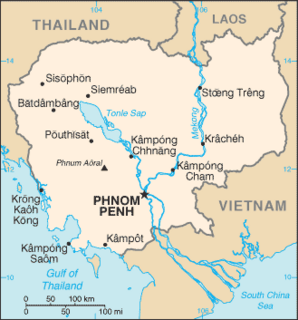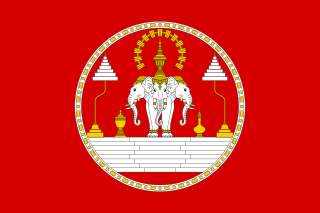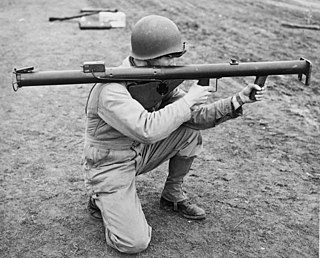
The Kingdom of Cambodia, informally known as the first Kingdom of Cambodia and the Sangkum Reastr Niyum era, referred to Norodom Sihanouk's first administration of Cambodia from 1953 to 1970, an especially significant time in the country's history. Sihanouk continues to be one of the most controversial figures in Southeast Asia's turbulent and often tragic postwar history.

The Cambodian Civil War was a military conflict that pitted the forces of the Communist Party of Kampuchea and their allies the Democratic Republic of Vietnam and the Viet Cong against the government forces of the Kingdom of Cambodia and, after October 1970, the Khmer Republic, which were supported by the United States (U.S.) and the Republic of Vietnam.
The Cambodian coup of 1970 refers to the removal of the Cambodian Head of State, Prince Norodom Sihanouk, after a vote in the National Assembly on 18 March 1970. Emergency powers were subsequently invoked by the Prime Minister Lon Nol, who became effective head of state, and led ultimately to the proclamation of the Khmer Republic later that year. It is generally seen as a turning point in the Cambodian Civil War. No longer a monarchy, Cambodia was semi-officially called "État du Cambodge" in the intervening six months after the coup, until the republic was proclaimed.

The Khmer National Armed Forces, often abbreviated to FANK, were the official armed defense forces of the Khmer Republic, a short-lived state that existed from 1970 to 1975, known today as Cambodia. The FANK was the successor of the Royal Khmer Armed Forces which had been responsible for the defense of the previous Kingdom of Cambodia since its independence in 1954 from France.
Operation Hardnose was a Central Intelligence Agency-run espionage operation spying upon the Ho Chi Minh trail that began during the Laotian Civil War. Started in Summer 1963, it soon attracted the attention of the U.S. Secretary of Defense, Robert McNamara. By December 1963, he was calling for its expansion. Operation Hardnose expanded and continued to report on the Ho Chi Minh trail even as American military intelligence activities mounted against the communist supply artery. In an attempt to adapt technology for use by illiterate Lao Theung, some of the U.S. Air Force's survival radios were modified by the CIA for use by their spies.
Operation Star was a highly classified military intelligence gathering program set up in late 1965 by the Royal Thai Government during the Vietnam War. It was co-located with the American Central Intelligence Agency's Operation Hardnose at Camp Siberia 26 kilometers northeast of Savannakhet, Laos. The operation was founded although American intelligence sources in the area already shared their results with the Thais. Royal Thai Special Forces assigned as instructors to Operation Hardnose were utilized as reconnaissance teams. In early 1967, the CIA eventually severed the Thai intelligence operation from the instructional duties for Lao irregular military troops.
Operation Junction City Jr. was a major Laotian offensive of the Vietnam War; initially aimed at temporary disruption of the Ho Chi Minh Trail, it was extended into an attempt to isolate the major North Vietnamese communist transshipment point at Tchepone from the units it was supposed to supply.
Operation Left Jab was the first military offensive launched against the Sihanouk Trail extension of the Ho Chi Minh Trail during the Second Indochina War. It was the first battalion-sized operation waged by the Royal Lao Army against the communists. Carried out between 21 and 26 June 1969, the assault interdicted Route 110 of the Sihanouk Trail for its planned three-day stoppage of military supplies. The Royalist guerrillas of Special Guerrilla Unit 2 then evaded an approaching counterattack and regrouped in friendly territory. Operation Left Jab had cleared the way for Operation Diamond Arrow.
Operation Honorable Dragon was an offensive of the Second Indochina War. The Central Intelligence Agency, which equipped and trained the needed troops, aimed at disruption of the North Vietnamese communist supply line, the Ho Chi Minh Trail. Launched by six battalions of Royal Lao Army military irregulars on 31 August 1970, the operation achieved only limited success. Although the planned objective was captured on 25 September, the offensive was plagued by desertions and combat refusals, including a battalion that ran from "ghosts". After the conquest of Pakse Site 26, troops of the People's Army of Vietnam (PAVN) harassed the Lao occupiers through mid-December 1970.
Operation Maeng Da was a Royal Lao Government military offensive aimed at disrupting the crucial communist supply route of the Second Indochina War, the Ho Chi Minh trail. Launched from a rendezvous point near Vang Tai, Laos, on 2 July 1970 as a three-battalion assault on the major People's Army of Vietnam (PAVN) transshipment center at Tchepone, Laos, it ran into stiff resistance from the PAVN 9th Regiment from 11–15 July. An attempt on 16 July to reinforce the Royalist Blue, Black, and Mobile 1 battalions by White Battalion was thwarted by PAVN ground fire and hazardously heavy air traffic over the battlefield. On 17 July, the worst hit Royalist unit, Black Battalion, was airlifted back out of battle. The other two Royalist battalions exfiltrated away from the PAVN troops. In the process, the commander of Mobile 1 was killed; the battalion lost all combat discipline. Both retreating battalions regrouped at the operation's start point. Although ancillary follow-up operations occurred in the vicinity throughout September, the Maeng Da offensive would not resume. However, the Central Intelligence Agency, which had trained and supported the Royalist guerrilla battalions, prepared the Tchepone Operation to follow it.
The Tchepone Operation was an interdiction campaign by the Royal Lao Armed Forces aimed at disrupting the People's Army of Vietnam (PAVN) supply line, the Ho Chi Minh trail. The pair of three-battalion Central Intelligence Agency-sponsored Royalist irregulars aimed at a communist garrison at Moung Phine, and the vital transshipment point of Tchepone. The Muang Phine thrust was fruitless. The Tchepone column stalled on Route 9 only 13 kilometers from the logistics center on 31 October. Between 1 and 10 November, the PAVN fiercely attacked while reinforced with nine antiaircraft guns and six mortars. The Royalist guerrillas retreated to base under cover of tactical air strikes by the Royal Lao Air Force and U.S. Air Force that inflicted heavy casualties on the PAVN, including close air support delivered within 20 meters of the Royalists. Analysis of the results of the Tchepone Operation convinced the CIA that regimental operations should replace multi-battalion ones.
Operation Silver Buckle, an offensive staged in Military Region 4 of the Kingdom of Laos, was the deepest Royal Lao Armed Forces penetration to date of the Ho Chi Minh Trail. Reaching the Trailside village of Moung Nong, the forward two companies attacked the rear of the 50,000 People's Army of Vietnam (PAVN) garrison on 8 February 1971, just as Operation Lam Son 719 was launched by the Army of the Republic of Vietnam (ARVN). Overrun and scattered while suffering serious casualties, the Groupement Mobile 30 irregular regiment of Silver Buckle had tied up at least six PAVN battalions, preventing them from opposing Lam Son 719.
Operation Phiboonpol was a "short but very intense engagement" of the Laotian Civil War. Five Royal Lao Government battalions went on the offensive in Military Region 4 of the Kingdom of Laos to try to regain the Boloven Plateau, which overlooked the vital Ho Chi Minh Trail lying to its east. Stopped in its tracks by the People's Army of Vietnam, with its first use of tanks in southern Laos, the Royalists held firm while close air support inflicted heavy casualties on North Vietnamese attackers. A Thai mercenary company sent as a Royalist relief force was ambushed and wiped out. For weeks after the battle, vultures feasted on unburied corpses.
Operation Bedrock (Laos) was a military offensive staged by the Royal Lao Armed Forces against the People's Army of Vietnam in Military Region 4 of the Kingdom of Laos. Its purpose was disruption of the supply of rice to Communist forces occupying the Ho Chi Minh Trail. It was successful.
Operation Sayasila was a major offensive military operation of the Laotian Civil War. It was staged by command of King Sisavang Vatthana. Launched on 26 July 1971 against the Ho Chi Minh Trail complex and its People's Army of Vietnam (PAVN) garrison, Sayasila was planned as a rather complex two phase operation dependent on coordinating two columns containing 4,400 troops with close air support in an attack on 1,100 Vietnamese Communist soldiers. When the assault stalled in mid-August, it was elaborated upon with two additional helilifts of Royalist troops behind the PAVN's mobile garrison. When the Royalist command failed to coordinate tactical movements among its various columns, the PAVN 9th Regiment moved to defeat Royalist aggressor columns one at a time. By 1 September, this Royalist attack had also failed.
Operation Sinsay was a Royal Lao Government offensive of the Laotian Civil War. The planned offensive was pre-empted by prior moves by the opposing People's Army of Vietnam (PAVN); they struck on 6 March 1972. Although the Communist attack reached Laongam, 21 kilometers from Pakxe and the Thai border, and the defending Royalist battalions there were reassigned to fight in Operation Strength on the Plain of Jars, monarchist guerrillas were able to interdict Communist supply lines and force a Vietnamese retreat by the end of March 1972.
Operation Fa Ngum was a Laotian military offensive aimed at capturing the villages of Ban Ngik and Laongam as bases for incursions onto the Ho Chi Minh Trail. The Central Intelligence Agency backers of Royalist guerrillas planned to use a combination of air mobility and route march assaults to clear Route 23 through the two towns. Defensive forces to be defeated were the People's Army of Vietnam 9th and 39th Regiments. At various times and in differing combinations, the Royalists would commit two regiments of guerrillas, a makeshift regiment of the Royal Lao Army, three battalions of Neutralists, and a detachment of armored cars. Fighting a two-phase battle, the Royalists displaced the two PAVN regiments back towards the Vietnamese border. The Royalists both gained and gave up the open air cemetery of Ban Ngik. The PAVN returned westward toward the Thai border as the Royalists fell back. Enfeebled by mutiny and a serious casualty rate, the Royalists ended Operation Fa Ngum with a weak defensive blocking position at Laongam on Route 23.
Operation Black Lion was a Royal Lao Government counter-offensive against a People's Army of Vietnam thrust that cut the Kingdom of Laos in two at Khong Sedone during May 1972. Two regiments of Royalist military irregulars retaliated on 15 June 1972, attacking the Communist 39th Regiment in an air assault while Royal Lao Air Force tactical air strikes hammered the 39th. During the next month, the 39th Regiment would suffer an estimated 360 casualties and be rendered ineffective for attacks. On 18 July, they retreated, leaving a rear guard to be overrun.
Unity was the code name for Thailand's covert supply of mercenary soldiers to the Kingdom of Laos during the Laotian Civil War. From 4 July 1964 until March 1973, battalions of Thai volunteers fought Communist insurgents on the Plain of Jars in Military Region 2. As the Hmong L'Armée Clandestine was sapped by ongoing casualties and a limited basis for replacements, Unity battalions replaced them.


















